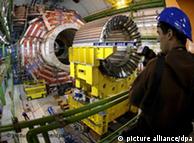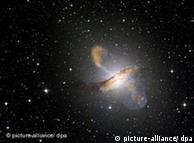It's the longest that a human eye has ever had the chance to look
at antimatter: Scientists at the European Organisation for Nuclear
Research (CERN) in Switzerland have managed to store antihydrogen atoms
which they had trapped for 16 minutes, they said on Sunday.
This, they hope, will bring them closer to solving the mysteries of antimatter.
"It may not be a scientific breakthrough because we always knew it
was possible, albeit very difficult," said Claus Grupe, a professor of
particle physics at Siegen University, "but it certainly is an
experimental breakthrough."
Normally, particles and anti-particles annihilate each other with a
lightning flash when they collide. The ALPHA team who conducted the
experiment at CERN managed to create what Grupe refers to as a 'soft
landing' of particles and anti-particles so they didn't annihilate each
other.
 CERN's Large Hadron Collidor (LHC) enables scientists to conduct experiments with matter and antimatter In
the study, published in the journal Nature Physics, the researchers
report trapping some 300 antiatoms. Last fall, the ALPHA team managed to
trap dozens of antimatter atoms and keep them for less than a second.
Nobody had ever achieved this before, but it was not enough to conduct
thorough experiments.
CERN's Large Hadron Collidor (LHC) enables scientists to conduct experiments with matter and antimatter In
the study, published in the journal Nature Physics, the researchers
report trapping some 300 antiatoms. Last fall, the ALPHA team managed to
trap dozens of antimatter atoms and keep them for less than a second.
Nobody had ever achieved this before, but it was not enough to conduct
thorough experiments.
Is there a world made up of antimatter?
At the time of the Big Bang, nearly 14 billion years ago, scientists
theorize that matter and antimatter probably existed in equal
quantities, today our universe is made up mostly of matter. For reasons
scientists have yet to figure out, nature developed in a way that it
preferred matter, and antimatter became extremely rare.
The scientific history of antimatter goes back quite some time, too:
Scientists were aware of its existence at the beginning of the previous
century, and they managed to prove its existence in the 1930s.
Since then, it has been one of physics' big unsolved mysteries, and
researchers have been trying to reproduce antimatter to analyze it
further. By that, they hope to find out if there are places that are
almost entirely antimatter instead, and what would happen on our planet
if we could harness it.
With the help of laser and microwave spectroscopy the ALPHA team hope
to be able to compare the particles to their hydrogen counterparts.
 In the early universe, there were equal parts matter and antimatter"We
can keep the antihydrogen atoms trapped for 1,000 seconds," said
Jeffrey Hangst, in a CERN statement. Hangst is a physicist at Aahus
University in Denmark, and spokesperson for the ALPHA team.
In the early universe, there were equal parts matter and antimatter"We
can keep the antihydrogen atoms trapped for 1,000 seconds," said
Jeffrey Hangst, in a CERN statement. Hangst is a physicist at Aahus
University in Denmark, and spokesperson for the ALPHA team.
"This is long enough to begin to study them, even with the small number that we can catch so far," he added.
Rethink our understanding of nature
"One of physics' biggest questions is in fact: are matter and
antimatter in our observable universe really asymetric," Grupe added.
"We assume that the world is made up of symmetries, but maybe we have to
think again."
The ALPHA team has started with conducting measurements and wants to present first results by the end of the year.
"It will be the first time anybody has interacted with antiatoms to probe their structure," Hangst said in the same statement.
Almost a philosophical question
The researchers will look for discrepancies in something called the charge-parity-time reversal (CPT) symmetry.
"If they find something, this would annihilate physics' golden rule," noted Grupe.
CPT means that a particle moving forward through time in our universe
should be indistinguishable from an antiparticle moving backwards
through time in a mirror universe.
"It would certainly mean we'd have to rethink our understanding of
nature if their study of antimatter proves that CPT symmetry doesn't
apply in this field," said Grupe. "That would mean it would become a
philosophical question."
Author: Nina Haase
Editor: Cyrus Farivar









